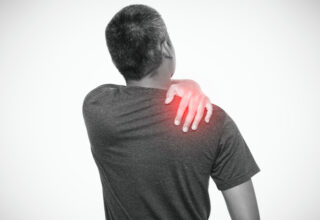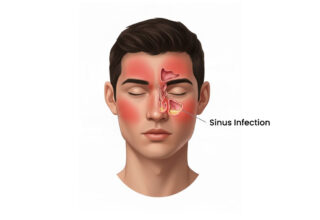Back pain between your shoulder blades can be quite uncomfortable. It makes it difficult to sit, sleep, or even take a deep breath. There can be many causes for this kind of pain. Sometimes it’s caused by something as simple as poor posture, and sometimes it can be a sign of something serious.
Let’s explore 7 common causes of back pain between shoulder blades and learn some simple tips to prevent it.
7 Common Causes of Back Pain Between Shoulder Blades
1. Muscle Strain or Overuse
This is the most common reason people experience pain between the shoulder blades. The muscles in this area (like the rhomboids and trapezius) work hard to support your posture, arm movement, and stabilisation of your shoulder blades.
Muscle strain (pulled muscle) can be caused due to poor posture, lifting heavy objects, or simply sleeping on a mattress that doesn’t give proper support.
There are many ways which can help relieve such pain. These include resting the affected area and applying warm compresses, stretching, keeping a good posture, and massage or physiotherapy.
Learn more about home remedies for chronic back pain.
2. Poor Posture
Slouching or hunching forward over a laptop or looking down at your phone for long periods can put strain on the muscles and ligaments of the upper back. Over time this causes stiffness, tension, and ache between the shoulder blades.
This is especially common in people who work at desks or drive for a long time.
Tip: Adjust your workspace ergomomically—keep your screen at eye level, support your back while sitting, and take regular breaks to stretch and walk around.
3. Spinal Problems (Herniated Disc or Arthritis)
Your spine runs through the middle of your back and neck. If there’s any problem here, the pain can radiate to the shoulder blade area.
A herniated disc or slipped disc occurs when the cushioning disc present between your vertebrae bulges out and presses on the nearby nerves—causing pain, tingling, or numbness. If the cervical (upper) spine is affected, it can cause pain in the neck or shoulder blades.
Arthritis can also cause pain between the shoulder blades when it affects the neck or upper spine. Spinal arthritis is the inflammation in the spinal joints where ligaments and tendons attach to the bones of the neck and spine.
The most common type is osteoarthritis which develops due to wear and tear over time.
However, rheumatoid arthritis—an autoimmune condition—can also target the neck and spine, which causes pain and stiffness.
4. Injury or Trauma
Injury or trauma is another possible cause of pain between the shoulder blades. This can result from incidents such as a sports-related collision, a fall from height, and a car or bike accident.
Such events can cause injuries like dislocated shoulder, dislocated rib, joint separation, or a rotator cuff tear. These injuries can cause damage to the muscles, ligaments, nerves, or even bones of the upper back.
5. Stress and Muscle Tension
Stress can affect your body in many ways. When you’re anxious or under pressure, your muscles—especially the ones around your shoulders and upper back—can become tense and knotted.
Over time this causes tightness aching, or even spasms between the shoulder blades.
Try to reduce your stress by taking slow, deep breaths throughout the day, doing gentle physical activity, or practicing mindfulness.
Even small relaxation habits can help your muscles relax and release tension.
6. Gallbladder or Digestive Issues
In some cases, the pain between your shoulder blades can be related to gastrointestinal problems.
Gallbladder problems, especially gallstones, can trigger sharp pain that radiates to the right shoulder blade, particularly after eating a heavy or fatty meal.
Similarly, acid reflux (GERD) can sometimes cause burning discomfort that’s felt between the shoulder blades.
Inflammation of the pancreas can also cause pain felt between shoulder blades.
If your back pain is accompanied with abdominal pain, nausea, or changes in digestion, it’s best to see your doctor and get yourself checked.
7. Heart or Lung Conditions
Sometimes pain between the shoulder blades can be a sign of something serious like a heart problem or lung condition.
Especially in women, there can be pain between shoulder blades before a heart attack rather than the classic chest pain. In this case the pain would be dull and persistent. Other warning signs may include chest pain, shortness of breath, dizziness, or sweating.
A pulmonary embolism (a blood clot in the lung) or aortic dissection (a tear in a major blood vessel—aorta) can also cause sudden, severe pain in the upper back.
These conditions need urgent medical care. So if you have these symptoms, don’t just wait—seek medical help right away.
When to See a Doctor
If you have severe pain or your pain is interfering with your daily activities you should see a doctor.
Even if your pain isn’t severe but doesn’t go away with rest or over-the-counter (OTC) pain relievers or it’s accompanied with other symptoms like numbness, tingling, or weakness, you should consult a doctor.
Your doctor would ask questions about your symptoms and might recommend imaging tests like X-ray or MRI to investigate the root cause of your pain.
Tips to Prevent Pain Between the Shoulder Blades
There are some simple lifestyle habits that can help keep your upper back healthy. These include:
- Maintaining a good posture—your shoulders relaxed and back supported
- Taking regular breaks from sitting or screens
- Staying active with exercises that strengthen your core and upper back muscles
- Stretching your shoulders and neck daily
- Keeping a healthy body weight to reduce pressure on your spine
- Managing stress with breathing techniques or yoga
Final Thoughts
Back pain between shoulder blades is common. In most cases it’s nothing serious and often caused by poor posture, muscle strain, or tension.
However, if your pain persists, becomes severe, or comes with other symptoms, don’t ignore it— get it checked by a doctor.
A few small changes like maintaining a good posture, movement, and stress management can go a long way in keeping your upper back healthy and pain free.








